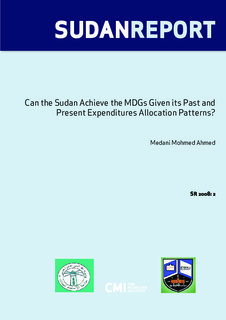Can the Sudan Achieve the MDGs Given its Past and Present Expenditures Allocation Patterns?
Research report
Permanent lenke
http://hdl.handle.net/11250/2475222Utgivelsesdato
2008-07-01Metadata
Vis full innførselSamlinger
- Publications [1488]
Originalversjon
Bergen: Chr. Michelsen Institute (Sudan Report SR 2008: 2)Sammendrag
In recent years there has been enormous concern about whether or not the Highly Indebted Poor Countries (HIPCs) and non-HIPCs will be able to meet the Millennium Development Goals (MDGs). Many scholars, decision makers and politicians have started to doubt whether the IMF and World Bank debt sustainability measures and debt relief under the HIPC Initiatives are appropriate and effective in order to achieve both debt sustainability and the MDGs in Low Income Countries (LICs). The IMF, the World Bank and some other concerned organisations and scholars have started to develop and encourage the development of new debt relief frameworks and models that will make debt sustainable and at the same time allow the LICs to achieve their MDGs. As a result, many serious studies have been made attempting to deal with these issues. The UNDP has spearheaded the efforts to incorporate and embed MDGs achievement in any worldwide efforts to sustain debt and/or programmes and initiatives to achieve the MDGs. In what follows we will review some of the contributions that have aimed to sustain debt relief and at the same time achieve the MDGs in LICs.
